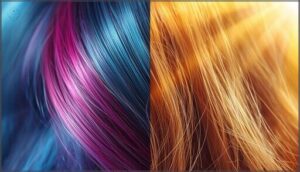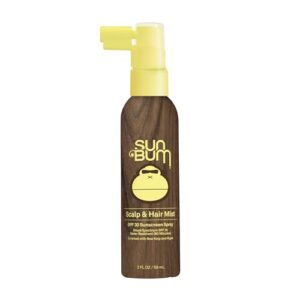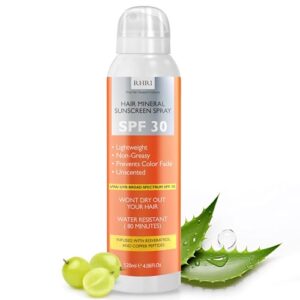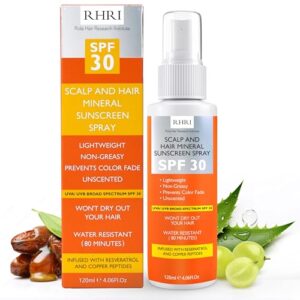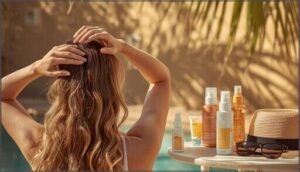This site is supported by our readers. We may earn a commission, at no cost to you, if you purchase through links.
Your scalp can burn in just 15 minutes of direct sun exposure. That’s faster than most other areas of your body. The thin skin up there has fewer oil glands and less natural protection.
When UV rays hit your scalp and hair repeatedly, you’re setting yourself up for two problems: cancer risk and damaged strands. Hair parts and thinning areas are especially vulnerable. The damage happens whether you notice redness or not.
Most people protect their face but forget what’s above it. A few simple habits can shield both your scalp skin and hair structure. You’ll prevent burns, preserve your hair’s strength, and reduce long-term cancer risk without complicated routines.
Table Of Contents
- Key Takeaways
- Why Sun Protection for Hair and Scalp Matters
- Effects of Sun Exposure on Hair Health
- Best Ways to Shield Hair and Scalp
- Choosing The Right Scalp and Hair Sunscreens
- Top 3 Hair and Scalp Sunscreen Sprays
- Tips for Effective Application and Hair Care
- Frequently Asked Questions (FAQs)
- How can I protect my hair and scalp while swimming in the ocean or pool?
- Can I use body sunscreen on my scalp?
- Does hair color affect sun damage vulnerability?
- Are there SPF hair styling products available?
- How does chlorine interact with hair sunscreen?
- Should children use different scalp sun protection?
- Conclusion
Key Takeaways
- Your scalp burns in just 15 minutes of direct sun because it has thin skin and fewer oil glands than other body areas, making UV protection critical for preventing both immediate burns and long-term skin cancer risk.
- UV rays break down keratin proteins in your hair through photooxidation, causing dryness, brittleness, color fading, and breakage—especially in chemically treated, fine, or curly hair types.
- Wearing UPF 50+ wide-brimmed hats blocks over 98% of UV rays while broad-spectrum SPF 30+ scalp sunscreen protects exposed part lines and thinning areas when reapplied every two hours.
- Timing outdoor activities outside peak sun hours (10 a.m. to 4 p.m.) cuts UV exposure by up to 80%, and seeking shade under trees or canopies reduces radiation by 60-90%.
Why Sun Protection for Hair and Scalp Matters
Your scalp and hair face real risks from the sun that go beyond a simple sunburn. UV rays can trigger skin cancer on your scalp and permanently damage your hair’s structure.
Here’s what you need to know about these threats and why certain areas need extra protection.
Risks of Sunburn and Skin Cancer on The Scalp
Your scalp faces real danger from constant UV radiation. Thin skin and exposed parts make sunburn strike fast—often before you notice. Here’s what you need to know about scalp protection and skin cancer prevention:
- Scalp skin absorbs more UV radiation than most facial areas
- Acute sunburn can happen with minimal exposure
- Repeated UV damage raises your risk of basal cell and squamous cell carcinoma
- DNA damage from UVB rays can trigger cancer development
- Thinning hair and part lines increase lifetime skin cancer risk
Sunburn prevention starts with understanding these risks. It’s also essential to apply rigorous scientific study methods to assess the effects of UV radiation on skin and scalp health.
How UV Rays Damage Hair Structure
UV radiation breaks down keratin proteins that form your hair’s core structure. When UV-B rays penetrate the cuticle, they weaken disulfide bonds and trigger photooxidation—creating reactive molecules that attack the fiber from within.
UV rays break down keratin proteins in your hair, weakening its structure from within through photooxidation
This cuticle wear leads to roughness, dullness, and increased porosity. Over time, your strands lose tensile strength, making them brittle and prone to breakage under normal brushing.
Increased Vulnerability in Parted or Thinning Hair
When hair density drops, your scalp faces far more UV penetration—the very problem that turns thinning hair into a sun-damage concern. Parted or sparse areas lose their natural shading, exposing skin to direct photoaging risks and heightened sunburn potential.
Here’s what happens with reduced hair coverage:
- Greater scalp exposure increases UV-related skin damage and potential skin cancer risk.
- Localized photoaging markers appear where thinning is most visible.
- Sun sensitivity rises, demanding stronger hair damage prevention and sun protection for hair strategies during outdoor time.
Effects of Sun Exposure on Hair Health
Sun exposure doesn’t just damage your skin. It weakens your hair from the inside out.
Here’s what happens when UV rays hit your hair and which hair types need extra protection.
Dryness, Brittleness, and Frizz
Sun exposure strips away your hair’s natural oils, leaving strands parched and prone to breakage. UV rays lift the cuticle and degrade keratin proteins, reducing moisture retention and tensile strength.
You’ll notice more frizz as damaged cuticles scatter light unevenly.
Proper hair protection with broad-spectrum products helps maintain hair moisture, aids in frizz control, and prevents ongoing sun damage to your hair health.
Color Fading and Premature Graying
UV damage accelerates pigment stability loss in dyed and natural hair alike. You’ll see color fade faster as UV rays degrade melanin granules and dye molecules through oxidative stress. Hair bleaching and chemical treatments heighten this vulnerability.
Premature graying appears more pronounced as sun exposure breaks down remaining pigment reserves. Broad-spectrum hair sunscreen and UPF-rated headwear preserve hair health and slow visible color loss.
Weakened Hair Strands and Breakage
UV exposure degrades keratin deep in your hair cortex, making strands brittle and prone to snapping. Oxidative stress lifts the cuticle while reducing moisture content, raising porosity and accelerating hair breakage. Heat compounds this damage during brushing.
Color-treated or previously damaged hair faces even greater risk because its structural integrity is already compromised.
Scalp sunscreen importance can’t be overstated for protecting hair health and preventing weakened strand repair needs.
Hair Types Most at Risk
Fine hair risks escalate because delicate strands lose protein faster under UV assault. Chemical damage from bleach or relaxers weakens your hair’s defense, making sun protection non-negotiable.
Curly hair care requires extra attention since textured strands develop porosity and dryness quickly. Thinning hair exposes more scalp to radiation, raising scalp sensitivity concerns. Shorter styles can’t shield vulnerable areas.
Your hair sunscreen becomes essential when hair types face these compounding hair damage threats.
Best Ways to Shield Hair and Scalp
Protecting your hair and scalp from sun damage doesn’t have to be complicated. You have several practical options that work well together or on their own.
Here are the most effective ways to shield both your hair and scalp from harmful UV rays.
Wearing UPF 50+ Hats and Wide Brims
Think of a quality hat as your scalp’s first line of defense. UPF 50+ hats block over 98% of UV rays, giving you serious sun protection during outdoor activities. Here’s what to look for:
- UPF ratings of 50+ on the label for verified protection
- Wide brims at least 3 inches to cover your scalp, ears, and neck
- Tightly woven fabrics like canvas or polyester that block UV rays effectively
- Crown coverage that protects your part lines completely
- Materials that maintain UPF when dry for consistent sun blockage
Your hat’s weaving and fabric quality matter as much as the brim width.
Protective Hairstyles to Reduce Exposure
Choosing the right style cuts your scalp’s UV exposure by 60-80%. Braided looks and updo trends provide a physical barrier against sun damage while keeping your hair care routine practical.
| Style Type | Sun Protection Benefit |
|---|---|
| Wide-brimmed hat styles | Block UV rays across scalp and face |
| Tight braids or buns | Shield large scalp portions during peak hours |
| Hair wraps with UPF fabric | Add extra defense beyond hairstyles alone |
| Low updos | Reduce shaft exposure and prevent hair damage |
Scarf protection works especially well for exposed part lines.
Avoiding Peak Sunlight Hours
Timing your outdoor activities around UV radiation levels makes a real difference. The sun’s rays hit hardest between 10 a.m. and 4 p.m., when peak sun hours deliver up to 80% more damage than early morning or late afternoon.
You’ll cut your cumulative sun exposure dramatically by planning beach days, hikes, or pool time outside this window. That’s smart sun protection without sacrificing fun.
Seeking Shade During Outdoor Activities
When you’re out under the sun, positioning yourself beneath shade structures cuts UV rays by 60-90%. Trees, outdoor canopies, and portable sun shade setups act as protective barriers that shield your scalp from direct exposure. Dense tree coverage alone reduces UV radiation by half.
During outdoor activities, these simple protective barriers let you enjoy fresh air while keeping your hair and scalp safer from damaging sun exposure.
Choosing The Right Scalp and Hair Sunscreens
Not all sunscreens work the same on your scalp and hair. You need a formula that protects without weighing down your strands or leaving residue.
Here’s what to look for when shopping for scalp and hair sunscreen.
Importance of Broad-Spectrum and SPF 30+
You need broad UVA/UVB coverage to protect your scalp from both sunburn and long-term damage. SPF 30 blocks about 97% of UV rays and works well for daily defense strategies.
Look for “broad spectrum” on the label—it confirms the scalp sunscreen guards against both ray types. This sun protection keeps your scalp safe from immediate burns and deeper harm over time.
Mineral Vs. Chemical Sunscreen Ingredients
Mineral sunscreens use zinc oxide or titanium dioxide to physically block UV rays. They sit on your scalp surface and rarely irritate sensitive skin.
Chemical formulas absorb rays instead, converting them to heat. That’s why some people experience scalp irritation with chemical options.
Both types can hit SPF 30 for solid protection. Mineral ingredients stay stable under sun exposure, while certain chemical filters break down faster and need frequent reapplication.
Lightweight, Non-Greasy, and Water-Resistant Formulas
You don’t want a sticky scalp all day. Look for spray formulations that dry fast and feel weightless. Mineral filters and chemical actives can both deliver nongreasy textures if the formula includes light emollients.
Water resistance matters too—many hair sunscreen products hold up for 40 to 80 minutes of swimming or sweating. That means your SPF product stays put when you need it most.
Fragrance-Free and Sensitive Skin Options
If your scalp reacts easily, fragrance-free options cut down on irritation. Mineral sunscreens with zinc oxide or titanium dioxide tend to sting less on sensitive skin. Look for labels that say “hypoallergenic” or “gentle formulas.”
These hair sun protection products skip masking agents and added scents. Patch-test a small area first. That way, your scalp care routines stay comfortable while you shield thinning spots.
Top 3 Hair and Scalp Sunscreen Sprays
You need a sunscreen that works on both hair and scalp without leaving a greasy mess. The right spray should offer broad-spectrum protection while keeping your hair looking natural.
Here are three reliable options that dermatologists recommend for daily sun protection.
1. Sun Bum Scalp And Hair Sunscreen Mist
Sun Bum Scalp And Hair Sunscreen Mist delivers SPF 30 broad-spectrum sun protection in a lightweight, fast-drying formula. You’ll appreciate the fine mist spray application that covers your scalp evenly without leaving residue.
This vegan product features sunscreen ingredients like vitamin E and sunflower seed oil for added hair care benefits. The 2-ounce bottle fits easily in your beach bag. It’s water-resistant and Hawaii Act 104 compliant.
You can use it on all hair types for reliable scalp protection during outdoor activities.
| Best For | People who spend a lot of time outdoors and need easy, effective sun protection for their scalp and hair without the greasy feel of traditional sunscreens. |
|---|---|
| SPF Level | SPF 30 |
| Product Size | 2 oz |
| Application Type | Mist |
| Formula Weight | Lightweight |
| UV Protection | Broad Spectrum UVA/UVB |
| Greasiness | May feel greasy |
| Additional Features |
|
- Broad-spectrum SPF 30 protection shields your scalp from UVA and UVB rays, helping prevent sunburn and long-term damage
- Lightweight, fast-drying mist applies evenly and won’t weigh down your hair or leave it feeling sticky
- Vegan formula with nourishing ingredients like vitamin E and sunflower seed oil is reef-safe and compliant with Hawaii Act 104
- The 2-ounce bottle is pretty small, so you’ll run through it quickly if you’re using it regularly
- Some users report it can leave hair feeling greasy or sticky despite the fast-drying claim
- Price point may feel steep considering the small bottle size and need for frequent reapplication after swimming or sweating
2. Hair Sunscreen Spray For Scalp Protection
You’ll protect exposed scalp skin with a broad-spectrum spray rated SPF 30 or higher. Mineral ingredients like zinc oxide offer gentler sun protection for hair and scalp sensitivity. Look for water resistance lasting 40 to 80 minutes during outdoor activities. Fragrance-free options reduce irritation risk, especially if you have sensitive scalp care needs.
Focus your spray application on part lines and the crown for even coverage. Scalp sunscreen spray reviews often highlight non-greasy formulas that won’t weigh down your hair while delivering reliable sunscreen for hair protection.
| Best For | Anyone with thinning hair, frequent part lines, or lighter hair color who spends time outdoors and needs reliable UV protection without heavy residue. |
|---|---|
| SPF Level | SPF 30 |
| Product Size | 4.06 fl oz |
| Application Type | Aerosol Spray |
| Formula Weight | Lightweight |
| UV Protection | Broad Spectrum UVA/UVB |
| Greasiness | Non-greasy |
| Additional Features |
|
- Broad-spectrum SPF 30 shields both scalp and strands from UVA/UVB damage that causes sunburn and color fading
- Lightweight aerosol design with 360° spray makes it easy to reach your part lines and crown without missing spots
- Water-resistant formula holds up during swimming, beach days, and sweaty outdoor workouts for 40-80 minutes
- Multiple users report spray nozzles failing or clogging, making the product unusable before it’s empty
- Some reviewers found the formula either too greasy for fine hair or not protective enough to prevent actual sunburn
- Limited guidance on how much to apply and how often to reapply means you might not get the full SPF 30 protection advertised
3. Hair Sunscreen Spray Protection
This 4-ounce travel-size bottle delivers SPF 30 broad-spectrum defense through mineral formulas with zinc oxide and titanium dioxide. Resveratrol and copper peptides work to fight free radicals while nourishing your scalp.
The lightweight spray application targets part lines and thinning areas without greasiness. Water resistance keeps your sun protection for hair active during outdoor activities.
Apply the unscented mist to dry hair before heading outside, focusing on scalp coverage where your hair parts. Reapply every two hours or after swimming to maintain effective UV filters and keep protecting hair from sun damage throughout the day.
| Best For | People with color-treated hair or sensitive scalps who spend time outdoors and want mineral-based sun protection that won’t weigh their hair down. |
|---|---|
| SPF Level | SPF 30 |
| Product Size | 4 oz |
| Application Type | Spray |
| Formula Weight | Lightweight |
| UV Protection | Comprehensive UV |
| Greasiness | Non-greasy |
| Additional Features |
|
- Mineral formula with zinc oxide and titanium dioxide offers broad-spectrum protection without harsh chemicals
- Lightweight spray targets exposed scalp areas and part lines without leaving a greasy feel
- Water-resistant for up to 80 minutes, making it practical for swimming and outdoor activities
- Some users report residue or greasy texture despite the lightweight claim
- Higher price point compared to regular sunscreen products
- Aerosol distribution system may cause uneven application in some cases
Tips for Effective Application and Hair Care
Applying scalp sunscreen correctly makes all the difference in actual protection. You need to know when and how to reapply throughout the day.
Here’s how to keep your hair and scalp shielded from sun damage.
How to Apply Sunscreen to Hair and Scalp
Proper technique makes all the difference in scalp protection. Start by parting your hair into sections to expose the skin. Spray or rub broad-spectrum SPF 30 sunscreen directly onto your scalp, focusing on part lines and hairlines.
Then gently massage the product in with your fingertips using circular motions. This ensures even hair coverage and effective UV defense without weighing down your strands.
Reapplying Sunscreen Every Two Hours
Your initial sunscreen application won’t last all day. You need to reapply every two hours to maintain effective UV protection on your scalp and hair. This sunscreen frequency becomes even more critical after swimming or sweating heavily.
| Activity | Reapplication Timing | Reason |
|---|---|---|
| General outdoor use | Every 2 hours | Sunscreen naturally degrades |
| After swimming | Immediately after | Water washes away coverage |
| Heavy sweating | When towel-drying | Sweat removes product |
| Peak sun hours | Every 90 minutes | Increased UV exposure |
Don’t skip this step—consistent reapplication ensures continuous scalp safety and hair coverage against sun damage.
Post-Sun Hair Washing and Hydration
After sun exposure, wash your hair with gentle, sulfate-free Hydrating Shampoos to remove salt and chlorine without stripping natural oils.
Follow with Gentle Conditioners or Moisture Masks to restore elasticity and repair damage. Seal in hydration using Scalp Serums or Hair Oils to combat frizz.
Rinse with lukewarm water—hot water causes additional moisture loss. These hair care tips support hair health maintenance and effective damage repair.
Using UV-Protective Leave-in Conditioners
After washing, apply leave-in conditioners with UV filters to keep your hair protected all day. These hair protection products combine conditioning agents with broad-spectrum UVA and UVB absorbers.
Choose water-resistant formulas that work during sweating or swimming. Fragrance-free options suit sensitive scalps best.
These conditioner formulas deliver continuous hair protection from sun damage while minimizing residue—essential hair care tips for maintaining healthy hair outdoors.
Frequently Asked Questions (FAQs)
How can I protect my hair and scalp while swimming in the ocean or pool?
Want to keep your scalp safe during laps? Apply water-resistant SPF 30+ hair sunscreen before diving in. Wear a UPF swim cap for scalp shields.
Rinse chlorine immediately, then use hydrating conditioners for pool hair care and damage repair.
Can I use body sunscreen on my scalp?
You can use body sunscreen on your scalp, but choose mineral formulas for sensitive skin. Avoid greasy products that weigh down hair. Reapply every two hours for proper scalp safety and sun protection.
Does hair color affect sun damage vulnerability?
Yes, hair color matters. Darker strands absorb more UV energy, while lighter hair offers less melanin protection. Both face color fading risks, but pigment shielding varies, influencing overall hair damage vulnerability.
Are there SPF hair styling products available?
SPF hair styling products combine sun protection with everyday styling. Look for broad-spectrum SPF 30 formulas with mineral sunscreen options like zinc oxide. These UV protective styling products shield your scalp and hair strands effectively.
How does chlorine interact with hair sunscreen?
Chlorine breaks down sunscreen film on your hair cuticle. It strips mineral filters faster than chemical ones.
This chemical interaction weakens scalp health protection and accelerates sun damage, requiring chlorine resistance formulas for hair protection tips.
Should children use different scalp sun protection?
Children need gentler Scalp Safety options. Pediatric Formulas with mineral ingredients like zinc oxide work best for Kids Protection.
Choose fragrance-free Child Sunscreen for sensitive skin.
Infant Care requires extra caution—always consult your pediatrician first.
Conclusion
Don’t let your guard down at the hairline. When you know how to protect hair and scalp from sun, you’re preventing burns, breakage, and cancer risk all at once.
Wear a UPF hat, apply broad-spectrum spray, and reapply every two hours. Skip peak sun when possible. These steps take minutes but deliver lasting protection.
Your scalp and strands will stay healthier, stronger, and safer for years to come.
- https://health.clevelandclinic.org/best-ways-to-protect-your-hair-from-sun-damage/
- https://pubmed.ncbi.nlm.nih.gov/19138021/
- https://www.glam.com/1121729/the-key-things-to-keep-in-mind-to-keep-your-color-treated-hair-healthy/
- https://my.clevelandclinic.org/staff/844-wilma-bergfeld
- https://x.com/godofprompt/status/1990526288063324577


